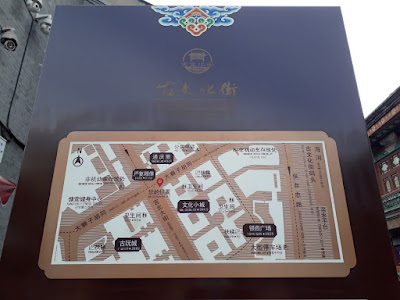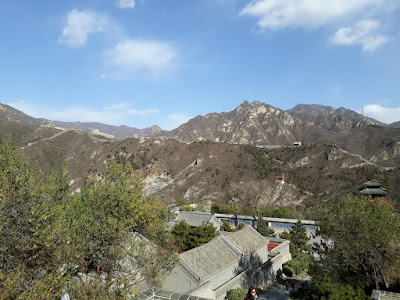 |
| Florentia Village Luxury Designer Outlet |
Florentia Village review of Florentia Village Luxury Designer Outlet in Wuqing Tianjin of China. The Florentia shopping village is a leading internationally famous brand outlet mall with a design inspired by classic Italian building styles. The shopping village luxury designer outlets mall has gathered over 200 European, American and Asian top luxury designer brands and offers top-level famous goods outlet at an average discount of up to 80% off. Florentia Village owns 6 shopping outlets mall in China Tianjin, Shanghai, Guangzhou, Hong Kong, Wuhan and Chengdu.
The Florentia Village luxury designer outlet mall address is located at north of Qianjin Road, Wuqing District, Tianjin of China. 5 kilometers away from Wuqing North exit (Yangcun Village) of Beijing-Tianjin and Beijing-Shanghai Highway, 100 meters to Wuqing Station of Beijing-Tianjin Interurban Railway.
The Florentia Village luxury designer outlet mall address is located at north of Qianjin Road, Wuqing District, Tianjin of China. 5 kilometers away from Wuqing North exit (Yangcun Village) of Beijing-Tianjin and Beijing-Shanghai Highway, 100 meters to Wuqing Station of Beijing-Tianjin Interurban Railway.
Florentia Village Luxury Designer Outlet
Florentia Village – Jingjin Wuqing Tianjin luxury designer outlet is developed by leading Italian fashion and retail giant RDM Group as its first flagship shopping and retail outlet in China, which sprang up near the port city of Tianjin in 2011. Florentia Village was designed as a full-function shopping and lifestyle center with true Italian heritage and unparalleled world-class design and management.
While strolling along a canal with gondolas flowing alongside reconstructed classic buildings, you discover sought-after fashion pieces from the world’s leading design houses. Visitors or travelers can indulge in a shopping extravaganza of nearly 200 international fashion brands such as Giorgio Armani, Salvatore Ferragamo, Prada, Armani Bulgari, Tod’s, Versace, Burberry, Celine, Zegna, Moncler, Missoni and Lancel, and popular lifestyle brands including Diesel, Coach, Guess, CK Jeans, Follie Follie, Samsonite and BMW Lifestyle. There are also British, US, and China-based retailers in the mix.
To ensure a genuine outlet experience, Florentia Village guarantees that all products are genuine with year round discounts across all stores. Value hunters can enjoy an average of 50% and up to 70% off domestic retail prices for items up to three fashion seasons for classic and fashion items from world leading luxury brands.
While strolling along a canal with gondolas flowing alongside reconstructed classic buildings, you discover sought-after fashion pieces from the world’s leading design houses. Visitors or travelers can indulge in a shopping extravaganza of nearly 200 international fashion brands such as Giorgio Armani, Salvatore Ferragamo, Prada, Armani Bulgari, Tod’s, Versace, Burberry, Celine, Zegna, Moncler, Missoni and Lancel, and popular lifestyle brands including Diesel, Coach, Guess, CK Jeans, Follie Follie, Samsonite and BMW Lifestyle. There are also British, US, and China-based retailers in the mix.
To ensure a genuine outlet experience, Florentia Village guarantees that all products are genuine with year round discounts across all stores. Value hunters can enjoy an average of 50% and up to 70% off domestic retail prices for items up to three fashion seasons for classic and fashion items from world leading luxury brands.
 |
| Florentia Village Luxury Designer Outlet Map |
Florentia Village Business Hours Review
Winter: 10:00 AM-8:00 PM (November 1st-March 31st)
Summer: 10:00 AM-9:00 PM (April 1st-October 31st)
Open at 9:00 AM during weekends and official holidays
Summer: 10:00 AM-9:00 PM (April 1st-October 31st)
Open at 9:00 AM during weekends and official holidays
How To Get To Florentia Village Luxury Designer Outlet Wuqing Tianjin
Free Shuttle Bus
For the convenience of customers, Florentia Village, Wuqing Tianjin, are providing free shuttle bus to the village(Every weekend and National Holidays).
1. Beijing Boarding Location: East Guomao Hotel, under the bridge of crossroads of Jingmao Street and Third Ring Road
2. Tianjin Boarding Location: Tianjin Guomao Shopping Center (Intersection of Nanjing Road and Machang Road)
3. Florentia Village Boarding Place: South-West corner of Florentia Village, Gate 2
The seat of the return shuttle bus needs to be reserved. Please take your ID card, receipt (amount not limited, except for catering, children who are under 1.2m tall do not need reservation) to make the return trip seat reservation. Each person is entitled to one ticket. In case multiple persons hold the same ticket, the ticket will be issued on first-come-first-serve basis. Passengers who do not have a receipt cannot reserve the seats. The reservation will be closed half an hour before the departure time.
1. Beijing Boarding Location: East Guomao Hotel, under the bridge of crossroads of Jingmao Street and Third Ring Road
2. Tianjin Boarding Location: Tianjin Guomao Shopping Center (Intersection of Nanjing Road and Machang Road)
3. Florentia Village Boarding Place: South-West corner of Florentia Village, Gate 2
The seat of the return shuttle bus needs to be reserved. Please take your ID card, receipt (amount not limited, except for catering, children who are under 1.2m tall do not need reservation) to make the return trip seat reservation. Each person is entitled to one ticket. In case multiple persons hold the same ticket, the ticket will be issued on first-come-first-serve basis. Passengers who do not have a receipt cannot reserve the seats. The reservation will be closed half an hour before the departure time.
High Speed Train
The high-speed train to Florentia Village ticket expenses can be reimbursed on the SAME day but it is only valid for:
1. One-way ticket departing from Beijing South Station or Tianjin East Station and arriving at Wuqing Station.
2. Shopping receipt whose RMB amount exceeds 1,000 (Food and beverage not included, except for Bella Vita) needed.
ID /passport is needed for the process of reimbursement.
Show the ticket for the way over and it will be in exchange of cash and thus not returned (Only for second-class seats; for customers departing from Beijing South Station, Florentia Village will refund RMB 38.5 in cash to each individual for one day; For customers departing from Tianjin East Station, Florentia Village will refund RMB 15.5 in cash to each individual for one day. It is not applicable for the Beijing-Tianjin inter-city railway transit.)
Testimonials above need to be shown when registering at the Customer Service center in Florentia Village Area A. Cash will be reimbursed on site upon verification. Only one ticket can be reimbursed for a person for one day.
Florentia Village covers the travel cost to make shopping economical and low carbon, making it delightful to visit and shop at ease. So that you can enjoy authentic Italian shopping styles, food and beverages from overseas and go for fashion items to achieve the highest level of satisfaction at Florentia Village Luxury Designer Outlet Wuqing Tianjin.
1. One-way ticket departing from Beijing South Station or Tianjin East Station and arriving at Wuqing Station.
2. Shopping receipt whose RMB amount exceeds 1,000 (Food and beverage not included, except for Bella Vita) needed.
ID /passport is needed for the process of reimbursement.
Show the ticket for the way over and it will be in exchange of cash and thus not returned (Only for second-class seats; for customers departing from Beijing South Station, Florentia Village will refund RMB 38.5 in cash to each individual for one day; For customers departing from Tianjin East Station, Florentia Village will refund RMB 15.5 in cash to each individual for one day. It is not applicable for the Beijing-Tianjin inter-city railway transit.)
Testimonials above need to be shown when registering at the Customer Service center in Florentia Village Area A. Cash will be reimbursed on site upon verification. Only one ticket can be reimbursed for a person for one day.
Florentia Village covers the travel cost to make shopping economical and low carbon, making it delightful to visit and shop at ease. So that you can enjoy authentic Italian shopping styles, food and beverages from overseas and go for fashion items to achieve the highest level of satisfaction at Florentia Village Luxury Designer Outlet Wuqing Tianjin.



















